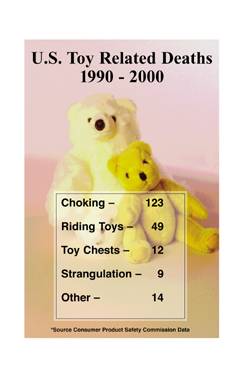
Dangerous toys mar holiday season
Hazardous toys can still be found in stores across the country, according to a nationwide survey released by the U.S. Public Interest Research Group (PIRG) and Vanderbilt Children’s Hospital.
The annual PIRG “Trouble in Toyland” report highlights potential hazards posed by toys found during a survey of stores in October and November. PIRG cautioned consumers about toy hazards in five categories: choking hazards including balloons, toxic chemicals, hearing loss hazards, scooter dangers, and purchasing toys on the Internet. PIRG also identified toys that do not have manufacturer information, making it difficult for consumers and government officials to identify and recall unsafe toys.
While the group’s 16th annual survey noted signs of improvement, an estimated 191,000 people went to emergency rooms for toy-related injuries last year. Seventy-nine percent (150,800) were younger than 15 years old.
More than 20,000 pediatric patients are seen annually in the VCH Emergency Department, of which 30 percent are admitted. VCH is Middle Tennessee’s only Comprehensive Regional Pediatric Center for emergency care and transfers.
Dr. Andrea Bracikowski, associate professor of Emergency Medicine and Pediatrics and director of the VCH Pediatric Emergency Medicine Department, urges parents to use caution and think of safety when purchasing toys for their children in the upcoming holiday season.
“It is important for parents to realize there are toys out there which can harm their children,” Bracikowski said. “This report can serve as an excellent guide for parents to follow when looking over their child’s holiday list.”
“Children needlessly choke to death on toys, and toys that pose hazards to children can still be found on store shelves,” said Jill Johnson, Southern Field Organizer with PIRG. “Consumers should remember that just because a toy is in the store, or doesn’t appear in PIRG’s report, that doesn’t mean it is safe,” she added.
Choking
Choking on small toy parts, balloons and small balls continues to be the leading cause of toy-related deaths. According to new data from the Consumer Product Safety Commission (CPSC), 207 children died from 1990 to 2000 playing with toys. In 2000, 17 children died playing with toys, six of those from choking.
Federal regulations ban any toy that poses a choking hazard because of small parts if it has “play value” for children under 3. The group also warned of the heightened choking hazards associated with small balls. Small balls (diameter of 1.25-1.75 inches) are banned for sale for children under 3.
Bracikowski said it was important for parents to pay attention to small parts on toys that can cause choking hazards.
“Tragically, children continue to choke on balls and other round or cylindrical toys that are small enough to block their airway,” Bracikowski explained. “Choking is one of the biggest problems that we treat in the emergency department.”
Across the nation, 57 children have choked to death on parts of balloons since 1990. PIRG criticized retailers for marketing balloons with familiar toddler images like Winnie the Pooh or with “Baby’s First Birthday” messages.
“Balloons are a leading cause of choking,” said Johnson. “Because of the choking hazard, balloons are inappropriate for toddlers. Consumers should avoid latex balloons altogether for children under 8, and even then use extreme caution.”
Toxic toys
The group warned consumers of toys containing toxic chemicals known as phthalates that are added to polyvinyl chloride (PVC) plastic toys as a softener. The chemicals are linked to liver and kidney damage, are probable human carcinogens, and have already been banned by several European countries in toys for children under 3.
“It is outrageous that manufacturers are making toys with toxic chemicals and often labeling them non-toxic,” Johnson said. “Young children should not be chewing on toxic toys.”
Hearing loss
PIRG identified a number of toys that pose hearing loss dangers to children. According to a 1998 study published in the Journal of the American Medical Association, almost 15 percent of children ages 6 to 17 show signs of hearing loss. No federal regulations regulate the noise level of toys, but toys with sounds of 85 decibels or over can significantly affect a child’s hearing.
“Toy givers must be aware of the dangers posed by loud toys,” Johnson said. “If a toy hurts your ears, don’t buy it for a child. Congress and the CPSC should develop noise limitation standards for children’s products.”
Scooter Safety
PIRG also offered tips to consumers about the use of scooters. Between January and July this year, scooters were responsible for 68,530 injuries that were serious enough to require emergency room treatment. About 85 percent of the injuries were to children younger than 15, with the most common injuries being fractures. CPSC has reports of 11 deaths relating to non-powered scooters this year.
Bracikowski said it was important to emphasize the use of safety gear for scooters, skateboards and bicycles.
“Children should always wear proper safety gear, including a helmet, knee and elbow pads, and wrist guards,” she said. “And it’s important for parents to emphasize that from the moment the child is given a bike, scooter, skateboard or skates.”
Christmas Ornaments
Bracikowski said an often-overlooked hazard during the holidays is the use of glass balls and lights on a Christmas tree—bright things which draw a child’s attention.
“We see several cases a year where the child has broken the glass ornament and eaten it,” she said. “Children are very fast and accidents happen so quickly, we need to remember to take precautions and protect our children.”













